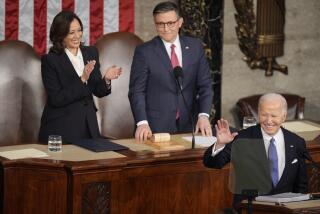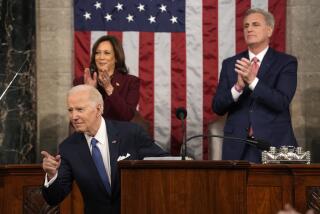R&D; Lags, Despite Presidential Puffery
- Share via
This is all President Bush had to say during his State of the Union address about the importance of research, development and new technology in boosting U.S. competitiveness and our quality of life:
“We must make common-sense investments that will help us compete, long term, in the marketplace. We must encourage research and development. My plan is to make the R&D; tax credit permanent, and to provide record levels of support, over $76 billion this year alone, for people who will explore the promise of emerging technologies.”
By contrast, the President invested a good chunk of his talk extolling the virtues of home building--while also proposing a cornucopia of tax incentives to support it.
“Real estate has led our economy out of almost all the tough times we’ve ever had,” he said. “Once building starts, carpenters and plumbers work and people buy homes and take out mortgages.”
So let’s see. It’s dangerous for America to have an “industrial policy” or a “technology policy,” but it’s now the highest economic priority to have a “real estate policy.” No doubt our ability to export world-class real estate will make a huge impact on our multibillion-dollar balance of trade deficit.
Indeed, even President Bush’s $76-billion government R&D; number is less a signal of commitment than a disingenuous bit of political puffery. According to the Office of Management and Budget, half that figure--$38 billion--goes into defense-related research and development, hardly the sort of investment that will guarantee a quantum leap in American industrial competitiveness. In fact, with the notable exception of NASA, most federal civilian R&D; expenditures are comparatively flat.
What’s more, America has no problem exploring the promise of emerging technologies--our problems begin when we try to commercialize those technologies and turn them into vibrant, competitive global products. The real issue isn’t how much we invest--it’s how much bang are we getting for our R&D; buck.
The disappointing reality is that President Bush’s speech completely overlooked the role that industrial and service innovations play in spurring economic growth. Indeed, the President stressed growth. He never once mentioned the word productivity-- the real indicator of whether our standard of living is destined to increase or erode. He didn’t point to any of America’s companies that are bucking the recession tide by skillfully and relentlessly focusing on productivity and innovation.
To be sure, a dramatic cut in capital gains can spur new investment. Changing depreciation schedules can boost short-term capital spending. But is the President best served by spreading tax incentives around the economy much the way a gardener spreads manure around his garden?
Yes, a 90-day freeze on “any new federal regulations that could hinder growth” is a provocative idea. But what about all those regulations--notably the rules requiring the auto industry to boost the mileage performance of their fleets--that spur innovation and growth? What role should the government play in crafting regulations that force industries to become more innovative? Or is that leading us down the slippery slope of industrial policy?
The issue here isn’t “the vision thing”--it’s having the leadership and courage to state a mission, to offer a goal. The failure of this State of the Union was not a failure of rhetoric or delivery; it was a failure for its unwillingness to articulate an appropriate role for government in boosting the standard of living of its citizens. It was a failure for not recognizing that growth without productivity isn’t prosperity--it’s coasting. It was a failure for not explicitly acknowledging that investing in innovation is key to any hope for sustained improvement in our economic quality of life.
The American economy is not an Iraqi-occupied Kuwait waiting to be liberated by industrial Schwarzkopfs. It is an enormously powerful behemoth whose psyche is just as important as its physique.
President Bush needed to talk about the importance of ongoing, cost-effective innovation as a cornerstone for economic recovery and sustained economic growth. He didn’t. It was a missed opportunity. Who will seize it?
More to Read
Inside the business of entertainment
The Wide Shot brings you news, analysis and insights on everything from streaming wars to production — and what it all means for the future.
You may occasionally receive promotional content from the Los Angeles Times.










